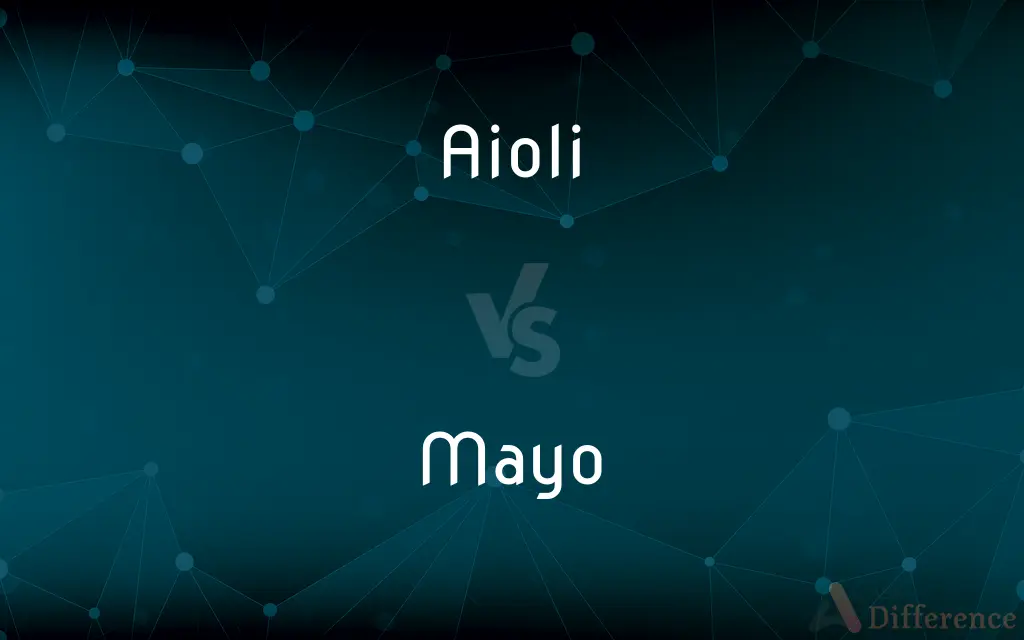Aioli vs. Mayo — What's the Difference?
By Tayyaba Rehman — Updated on September 25, 2023
Aioli is a flavorful sauce made from garlic, olive oil, and often egg yolks, originating from the Mediterranean, while mayo is a stable emulsion of oil, egg yolks, and either vinegar or lemon juice.

Difference Between Aioli and Mayo
Table of Contents
ADVERTISEMENT
Key Differences
Aioli and mayo are both popular condiments, but they have distinctive compositions and origins. Aioli, traditional to Mediterranean cuisine, is known for its robust flavor, primarily made from garlic, olive oil, lemon juice, and often egg yolks. It is used to enhance the flavor of various dishes, offering a garlicky and vibrant taste. Mayo, on the other hand, is a mild-flavored, creamy condiment composed of oil, egg yolks, and either vinegar or lemon juice, often used as a spread or a base for dressings and sauces.
Mayo, with its subtle and versatile flavor, serves as a crucial ingredient in numerous culinary creations, acting as a binding agent for salads and providing a creamy texture to sandwiches and burgers. It is universally known and extensively used in various cuisines. In contrast, aioli, with its pronounced garlic flavor and thicker texture, is generally used as a dip or a spread, complementing dishes like seafood, grilled vegetables, and meats, and is especially popular in Mediterranean cuisine.
Aioli’s defining characteristic is its predominant garlic flavor, distinguishing it from mayo. While both can have a creamy texture, aioli often has a more robust and richer flavor profile, owing to the presence of garlic and olive oil. Mayo, with its neutral taste, provides a smooth and creamy consistency to dishes, serving as a backdrop that allows other ingredients to shine, making it a versatile addition to diverse recipes.
While mayo is often used as a base to create various flavored mayonnaises by adding different ingredients like herbs, spices, or other flavorings, aioli, with its bold flavor, is usually enjoyed in its original form, highlighting the garlic and olive oil. Both condiments, with their distinct tastes and textures, offer unique enhancements to the culinary world, enriching a wide range of dishes with their respective flavors.
The differentiation between aioli and mayo is substantial, considering their individual flavor profiles and usages. Aioli’s garlic and olive oil components bring a zesty and flavorful impact to dishes, while mayo’s mild and creamy nature makes it a versatile culinary element, providing balance and richness to a variety of recipes.
ADVERTISEMENT
Comparison Chart
Base Ingredients
Garlic, olive oil, and often egg yolks.
Oil, egg yolks, and either vinegar or lemon juice.
Flavor Profile
Robust, garlicky, and vibrant.
Mild, creamy, and subtle.
Origin
Mediterranean cuisine.
Developed separately in various cuisines.
Common Use
Served as a dip or a spread with a variety of dishes, especially in Mediterranean cuisine.
Used universally as a spread, binding agent, or base for dressings and sauces.
Texture
Often thicker due to the inclusion of olive oil.
Creamy and smooth.
Compare with Definitions
Aioli
A robust condiment, traditional to Mediterranean regions, offering a pronounced garlic taste.
Aioli is a flavorful alternative to mayo, enhancing dishes with its garlicky essence.
Mayo
A widely-used, creamy condiment, versatile in flavor and application.
A spoonful of mayo balanced the acidity and added richness to the dish.
Aioli
A sauce, thickened with egg yolks, olive oil, and flavored predominantly with garlic.
A dollop of aioli elevated the dish, blending harmoniously with the other ingredients.
Mayo
A neutral-flavored, creamy condiment, often used to balance or enhance the flavors in a dish.
The addition of mayo provided a creamy contrast to the spicy flavors of the dish.
Aioli
A Mediterranean sauce made primarily of garlic and olive oil; may contain egg yolks.
The aioli complemented the grilled vegetables with its rich garlic flavor.
Mayo
A stable emulsion of oil, egg yolks, and either vinegar or lemon juice.
Mayo adds a creamy texture and mild flavor to sandwiches and salads.
Aioli
A creamy, often thicker sauce, enriched with the flavors of garlic and olive oil.
The homemade aioli was a hit, adding a zesty twist to the appetizers.
Mayo
A smooth, creamy sauce used universally in various cuisines as a base or spread.
Mayo is a staple in many households, used in countless recipes for its subtle flavor.
Aioli
A garlicky, vibrant sauce often used as a dip or spread in Mediterranean cuisine.
The fresh aioli added a flavorful punch to the seafood dish.
Mayo
A binding agent in many dishes, providing a mild, creamy flavor and texture.
The mayo in the salad acted as a binding agent, bringing all the ingredients together harmoniously.
Aioli
Aioli, allioli or aïoli ( or ; Provençal Occitan: alhòli [aˈʎɔli] or aiòli [aˈjɔli]; Catalan: allioli [ˌaʎiˈɔli]; Spanish: alioli [ˌaliˈoli]) is a sauce made of garlic, salt, and olive oil and found in the cuisines of the northwest Mediterranean, from Valencia to Calabria. The names mean "garlic and oil" in Catalan/Valencian and Provençal.
Mayo
Mayonnaise.
Aioli
A rich sauce of crushed garlic, egg yolks, lemon juice, and olive oil.
Mayo
Clipping of mayonnaise
Pass me the mayo please.
Aioli
A type of sauce, similar to mayonnaise, made from garlic, egg, lemon juice and olive oil.
Mayo
A white person.
Aioli
A French garlic-flavored mayonnaise. It is often served with fish and other seafood, and sometimes with vegetables.
Mayo
Egg yolks and oil and vinegar
Aioli
Garlic mayonnaise
Common Curiosities
Is aioli thicker than mayo?
Typically, aioli can be thicker due to the inclusion of olive oil and less liquid.
Is aioli always made with garlic?
Traditionally, yes, aioli is known for its predominant garlic flavor.
Is the egg yolk necessary for making mayo?
Yes, egg yolk acts as an emulsifier in mayo, contributing to its stable, creamy texture.
Can aioli and mayo be used interchangeably in recipes?
They can be swapped based on personal taste preferences, but they have distinct flavors, so it will alter the taste of the dish.
Which one is more popular worldwide, aioli or mayo?
Mayo is more universally known and used due to its mild and versatile flavor.
Which has a more neutral flavor, aioli or mayo?
Mayo has a more neutral and mild flavor compared to the robust and garlicky flavor of aioli.
Is mayo more versatile than aioli in cooking?
Mayo is considered more versatile due to its mild flavor, serving as a base for various dishes, sauces, and dressings.
Is aioli used as a spread like mayo?
Yes, aioli can be used as a spread, dip, or complement to various dishes, similar to mayo.
Can mayo have flavors added to it?
Absolutely, mayo often serves as a base for various flavored mayonnaises by adding herbs, spices, or other flavorings.
Is mayo a type of aioli?
No, mayo and aioli are distinct; aioli has garlic and olive oil as base ingredients, while mayo has a milder flavor with no garlic.
Can aioli be used as a base for other sauces like mayo?
Generally, aioli is enjoyed in its original form due to its bold flavor, but it can be modified based on individual preferences.
Can I make aioli without egg yolks?
Traditional aioli recipes often include egg yolks, but there are variations that omit them, focusing on garlic and olive oil.
Can aioli be made without olive oil?
Olive oil is a traditional ingredient in aioli, but variations might use other oils while maintaining the garlic flavor.
Is mayo usually homemade or store-bought?
While mayo can be made at home, it is commonly store-bought for convenience.
Can I use olive oil to make mayo?
Yes, olive oil can be used to make mayo, but it will impart a distinct flavor to the mayo.
Share Your Discovery

Previous Comparison
Mrs vs. Madam
Next Comparison
Mythology vs. MythAuthor Spotlight
Written by
Tayyaba RehmanTayyaba Rehman is a distinguished writer, currently serving as a primary contributor to askdifference.com. As a researcher in semantics and etymology, Tayyaba's passion for the complexity of languages and their distinctions has found a perfect home on the platform. Tayyaba delves into the intricacies of language, distinguishing between commonly confused words and phrases, thereby providing clarity for readers worldwide.
















































